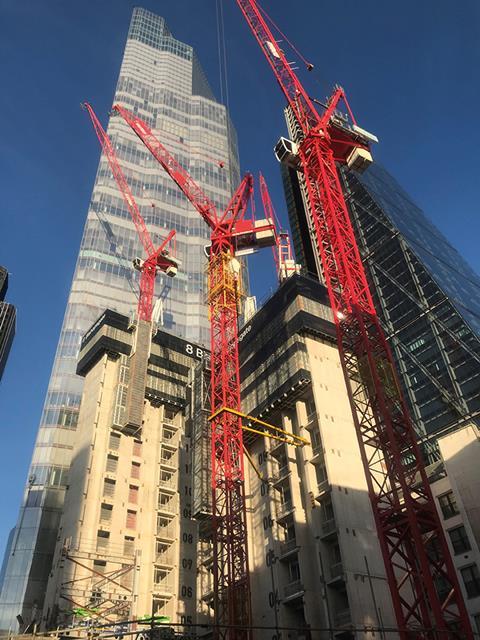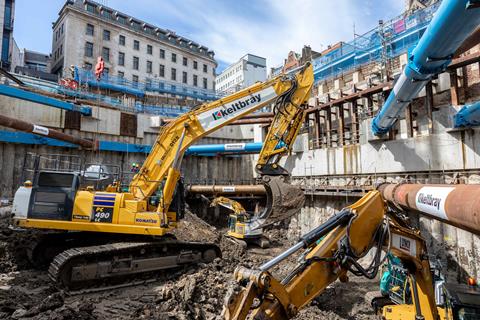The specialist contractorŌĆÖs owner talks to Dave Rogers about going back to building, succession planning and why he never intends to quit

Brendan Kerr says KeltbrayŌĆÖs strategy was always to offload its infrastructure business. ŌĆ£First and foremost, it was set up to sell ŌĆō that was always my plan.ŌĆØ
The infrastructure business began in 2009 with the acquisition of Gamble Rail, gradually adding bits, such as the Aspire overhead line contractor, in 2010, launching an energy arm three years later and buying the highways division of collapsed building and civils firm NMCN three years ago. By the time it did sell infrastructure to private equity in August, the company had a turnover of ┬Ż378m, according to its latest annual report, and employed 1,100 people.
Infrastructure earnings were around ┬Ż20m and KeltbrayŌĆÖs owner says he sold the firm for nine times that. Simple maths suggests, then, a price of ┬Ż180m. Kerr wonŌĆÖt confirm the number but admits that itŌĆÖs ŌĆ£well north of ┬Ż100mŌĆØ.
The deal with EMK Capital, based in LondonŌĆÖs Hanover Square, saw Keltbray ŌĆō which was set up in the 1970s and which Kerr has been running since 2003 ŌĆō go back to focusing on the built environment. This means its London commercial work, as well as sectors such as data centres, battery plants, energy schemes such as nuclear, and jobs like HS2. ŌĆ£We wonŌĆÖt be doing road, rail or power.ŌĆØ
Its retained business includes demolition, sub and super structures. ŌĆ£IŌĆÖm still a civil engineer,ŌĆØ Kerr is quick to point out.
He has no stake in the offloaded business, which is run by former Keltbray chief executive Darren James who joined just before covid after three decades at Costain.

The new company is expected to change its name by Christmas and Kerr adds that the pair have a non-compete agreement in place.
The initial plan was to keep James and sell off infrastructure, but ŌĆ£a few honest conversationsŌĆØ during covid meant that James would leave with infrastructure once it was sold. ŌĆ£Darren was always going to be infrastructure, inside out, back to front. Darren was up for that and saw [the sale] as a good opportunity for him as well.ŌĆØ
The decision to sell up, Kerr says, was made a couple of years ago with the firm hiring the Royal Bank of Canada (RBC) to handle the disposal and find a buyer.
It was either going to be private equity or a trade sale, but RBC said the business would fetch more if it was sold to private equity. More than 30 firms expressed interest, which was then whittled down to 20, then a dozen, halved, and then best and final offers were made by two firms.
If you are just purely dependent on the London market, youŌĆÖd be out of business
What Kerr is left with is a built environment business which, according to its last set of accounts, has a turnover of ┬Ż311m and around 800 staff. He says the plan now is to grow the business back up to ┬Ż500m, with around 1,000 employees.
He admits that the current market is facing several headwinds, such as investors delaying decisions on schemes. Like many, he laments the paucity of margins.
ŌĆ£A specialist contractor like us, we were always told by accountants that our margins should be 7%. Since 2019, we havenŌĆÖt priced a job for more than 1.5%.ŌĆØ
>> See also: Stepping back: the story of 8 Bishopsgate
>> See also: In business: on the road with Keltbray
He says that cost consultants and lawyers ŌĆ£have a lot to answer forŌĆØ in helping drive down profits. ŌĆ£The fee bubble has taken over from the bloke with the shovel in his hand. If the industry was operating properly and normally and fairly in the past five years, there wouldnŌĆÖt be all these distressed businesses.ŌĆØ
Brexit, covid and rampant cost inflation caused by the war in Ukraine have all contributed to dwindling margins and Kerr admits that the days when London was the be all and end all are gone for him ŌĆō hence the move into sectors such as data centres and battery plants.
ŌĆ£London is still a safe market but, if you are just purely dependent on the London market, youŌĆÖd be out of business. I love the London market but I wouldnŌĆÖt want to be solely reliant on it.ŌĆØ
I couldnŌĆÖt give it up, itŌĆÖs a drug. I enjoy the challenge. I hate losing
Kerr turns 60 next August but has no plans to wind down. He sees himself continuing as executive chairman for the next decade at least and acknowledges that he is unlikely ever to fully quit the business. ŌĆ£I enjoy doing it, IŌĆÖm passionate about it.ŌĆØ
He adds: ŌĆ£I see myself as incredibly active for the next 10 years. I couldnŌĆÖt give it up, itŌĆÖs a drug. I enjoy the challenge. I hate losing.ŌĆØ
All this does not mean, though, that he hasnŌĆÖt thought about a succession plan. Corporate governance was tightened up under James and he says that Vince Corrigan, formerly chief operating officer but now chief executive and who joined Keltbray from Sir Robert McAlpine nine years ago, will be at the business for the next few years.
Kerr had brought in headhunters over the summer to sound out replacements, but says: ŌĆ£Vince is 62, going on 52. We donŌĆÖt see anyone out there at the moment. I see Vince here for the next two or three years.ŌĆØ
The succession plan, he says, is likely to involve CorriganŌĆÖs long-term replacement and his two sons, Ryan and Sean, both in their 30s, who work in the business. A third son, Liam, works overseas in the hotel industry.
One thing Kerr is definite about is that the firm will not become employee-owned. ŌĆ£All [private] companies should be owned by a proper major shareholder or two or three shareholders. IŌĆÖm not sure employee-owned trusts are good for the industry. Look at their track record [Buckingham and Lonsdale were EOTs at the time of their collapses]. ItŌĆÖs the end of the line for the owner. ItŌĆÖs not how I see succession planning for a family business.ŌĆØ
Keltbray will remain in Esher, Surrey, although it is looking at moving out of its current home opposite Sandown racecourse and into smaller offices elsewhere in the town. It has a location in central London at Farringdon ŌĆō its neighbour will be its former infrastructure business ŌĆō and Kerr reckons that this office will be able to hold 150 staff.
By then, he hopes he will have drawn a line under its appeal against the size of the fine by the Competition and Markets Authority for its involvement in the demolition sectorŌĆÖs bid-rigging scandal.

Keltbray has argued that the amount of ┬Ż16m, announced last March, is too severe and has so far spent more than ┬Ż500,000 on legal fees. Kerr reckons it will hit seven figures by the time it is all over.
The tribunal to hear the firmŌĆÖs appeal was held in the spring. He canŌĆÖt talk too much about the case but a decision is due before Christmas.
There is still time left for him to show the sort of enthusiasm that keeps him going. HeŌĆÖs talking the weekend after the firm has poured 1,600m3 of concrete at the Salisbury Square development in London, sometimes known as the Justice Quarter on Fleet Street, which is being built by Mace.
ŌĆ£ItŌĆÖs one of the biggest pours in London in the past 20 years,ŌĆØ Kerr marvels. ŌĆ£WeŌĆÖre still one of the leading lights in London.ŌĆØ


























No comments yet